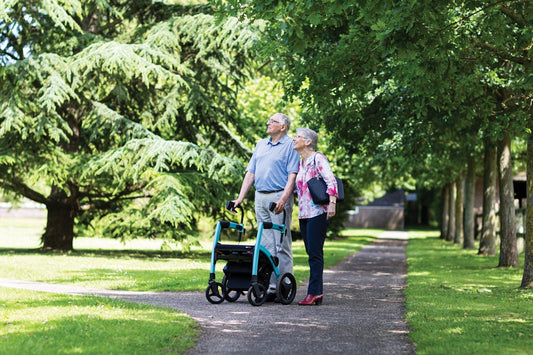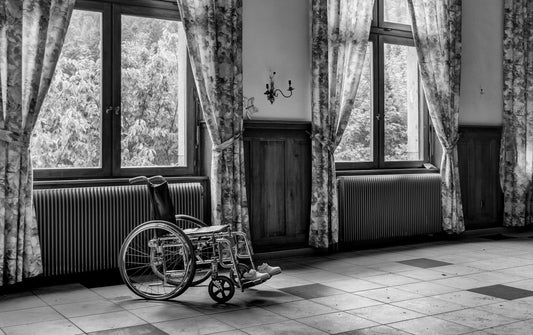
What Is The Difference Between A Walker And A Rollator?
Do you know more about the different mobility aids designed to help and support those with limited mobility? However, there are many, but the two most common mobility aids are rollators and walkers. It might already know what these terms mean! They are designed to serve the same purpose: mobility, but sometimes it’s necessary to know their differences so that you can make the right decision based on the needs of yourself or your loved ones. Today, we will provide clear differences between walkers and rollators and how they can be used to improve mobility. Let’s learn how each type of mobility aid can help you.
What Is a Walker?
Walkers are usually made of lightweight materials like aluminum or steel. Their mobility and robust support make them ideal for moving.
A standard walker, characterized by its wheel-less legs, necessitates lifting and moving it forward. If enhanced mobility is what you’re looking for, accessories can be purchased that will allow you to slide. Before taking each step, you will need to lift and lower the walker so you are ready to take the next one. Although it offers partial body weight support and aids in maintaining balance while walking, it lacks a seat, unlike some other mobility aids. Additionally, hybrid models featuring two front wheels bridge the gap between traditional walkers and rollators, providing a versatile solution that lies between the two.
Features of Walkers:
Stability Walkers have a reputation for exceptional stability. They are an excellent choice for people who need substantial support when walking or standing. The wide base of the four-legged design reduces the chance of tipping.
- Basic Design: As far as the design of the walker is concerned, it comes with a frame and four legs, along with hand grips on both sides. Some models also have wheels on the front feet, so users don’t need to lift the walker to go forward.
- Height Adjustment: The majority of walkers can be adjusted to fit the user’s specific needs. The adjustable height of walkers enables you to walk comfortably. It also keeps a good posture by reducing the stress on the body. Moreover, you can stay focused and alert while walking, which reduces the risk of injury when walking for extended periods of time.
- Indoor Usage: Walkers can be used indoors, especially in areas with tight corners or narrow hallways. Compact design allows for easy manoeuvrability even in tight spaces. You can easily use walkers indoors, especially in congested areas or narrow hallways.
- Lightweight: Walkers are also lightweight and easy to transport, making them ideal for people who need to move their walkers from place to place. Walkers can be customized with accessories such as baskets and holders for items for added convenience.
What Is a Rollator
A roller is a modern mobility aid that combines the features of a walker with other functionalities. The fact that it has wheels, brakes, and a seat makes it a rolling walker. Rollators provide stability but also freedom of movement and convenience.
Rollator in Canada are also known by various names, such as rolling walkers, wheeled walkers, and medical rolling walkers. A distinctive feature of rollators is that all of their legs are equipped with wheels, enabling them to effortlessly glide forward without requiring lifting for each step.
However, it’s important to note that rollators are not intended for bearing body weight, as relying on them for support in this manner can potentially lead to accidents and falls. While rollators provide valuable assistance while seated, they are not designed to offer stability during walking.
Features of Rollators:
- Wheels: Each of the four legs on a rollator has wheels. The user can move more easily without having to lift the device each time they step. This feature is particularly beneficial for those with reduced upper body strength.
- Brakes: The brakes on a rollator are one of the most distinctive features. The brakes are generally located on the handle of a rollator. The brakes can be locked to slow or stop the device.
- Seat: The seat is a distinctive feature. The built-in seat can be used to take a break or rest during walks. This is an excellent option if you are easily tired or need to rest.
- Storage Options: Many rollators include storage options such as pouches and baskets. This feature allows the user to carry personal items, groceries, or medical needs without having to use an additional bag.
- Outdoor Versatility: A rollator is ideal for outdoor use because of its wheels. The larger wheels can handle different terrains, from parks to sidewalks. The user can be more comfortable outdoors.
What does type 1, 2, and 3 mean?
In order to categorize walkers and rollators, they are divided into three types: Type 1, Type 2, and Type 3.
- All walkers, regardless of whether or not they have wheels, fall under the Type 1 category. They are best suited for temporary use.
- Type 2 rollators have smaller wheels that are typically 4 to 6 inches wide. These Type 2 Rollators are designed for indoor and even terrain use, such as in retirement homes, on short walks around the neighborhood, and in similar situations.
- Type 3 rollators have larger 8-inch tires. The Type 3 category is a more mobile option, with a seat and larger wheels.
How to Choose Between a Walker and a Roller: Walker vs. Rollator
Depending on a range of factors, such as the user’s physical ability, mobility needs, and intended usage scenarios, it is necessary to consider a number of factors before deciding whether a walker or roller is appropriate for them. However, we have listed a few things that you should consider before you make your final decision between the two:
- Stability and manoeuvrability: A walker is a better option if stability is your primary concern. The wide base and simple design of this walker provide robust support for those who require extra help with balance.
- Freedom of Movement: The wheels of a rollator allow for greater freedom of movement. The wheels of a rollator can make walking easier for a user with good balance who wants to live an active lifestyle.
- Indoor vs. Outdoor Use: Think about where you will use the mobility aid most often. You can use rollators both indoors and outdoors. Walkers are best for indoor environments. For instance, if the user is able to walk short distances without assistance, a walker may be more suitable. Alternatively, if the user needs more support with balance and mobility, a roller may be the better option. Additionally, if the user intends to use the device on uneven terrain, a roller is typically better suited.
- Resting needs: A rollator seat is a great option for users who need frequent breaks or have difficulty walking long distances. A seat can help prevent fatigue and improve overall comfort.
Conclusion
Both walkers and rolling canes are essential mobility aids that help people with limited mobility to regain confidence and independence. The user’s needs, physical abilities, and lifestyle preferences will determine which one is best for them. Rollators offer increased manoeuvrability and features such as brakes and seats, whereas walkers provide stability and simplicity.







